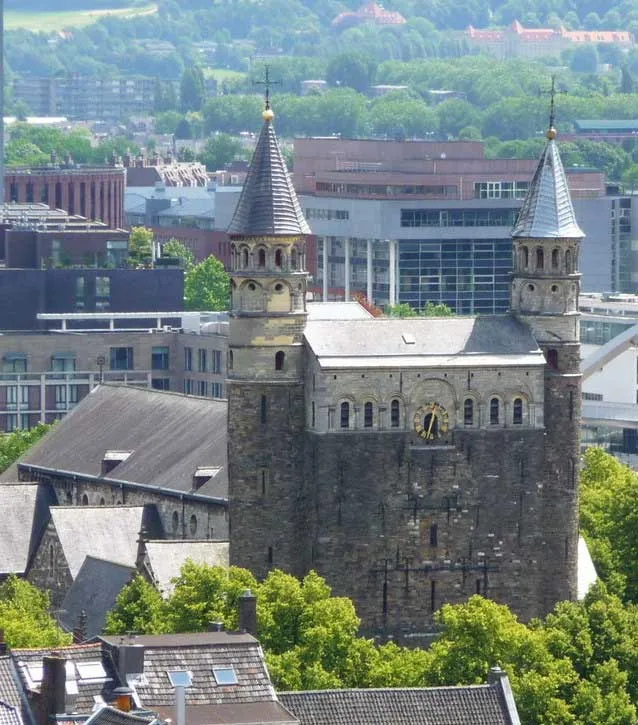
Introduction
The Basilica of Our Lady of Maastricht is a Romanesque Church in the historic centre of Maastricht, Netherlands. The church is dedicated to Our Lady of the Assumption and is a Roman Catholic parish church in the Diocese of Roermond. The church is often referred to as the Star of the Sea, after the church’s main devotion, Our Lady, Star of the Sea.
The present-day church is probably not the first church that was built on this site. However, since no archaeological research has ever been carried out inside the building, nothing certain can be said about this.
The church’s site, inside the Roman castrum and adjacent to a religious shrine dedicated to the god Jupiter, suggests that the site was once occupied by a Roman temple. It is not unlikely that the town’s first church was built here and that this church in the 4th or 5th century became the cathedral of the diocese of Tongeren-Maastricht.
Sometime before the year 1100 the church became a collegiate church, run by a college of canons. The canons were appointed by the prince-bishop of Liège. The provosts were chosen from the chapter of St. Lambert’s Cathedral, Liège. The chapter of Our Lady’s had around 20 canons, which made it a middle-sized chapter in the diocese of Liège. Until the end of the chapter in 1798 it maintained its strong ties with Liège.
Parishioners of Our Lady were identified in old documents as belonging to the Familia Sancti Lamberti. It is clear that the chapter of Saint Servatius was the more powerful institution in Maastricht, with strong ties to the emperors of the Holy Roman Empire, but throughout the Middle Ages the two churches remained rivals.
Most of the present church was built in the 11th and 12th centuries. Construction of the imposing west work started shortly after one thousand AD. In the 13th century the nave received Gothic vaults. Around 12th century the canons abandoned their communal lifestyle, after which canons houses were built in the vicinity of the church.
History of Basilica of Our Lady of Maastricht
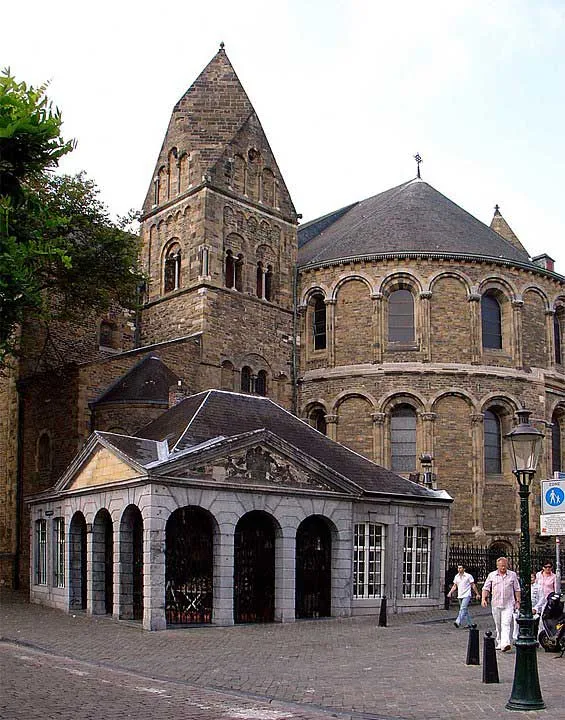
In the 14th century a parish church was built next to the collegiate church, so the main building could be reserved for the canons’ religious duties of this parish church, dedicated to Saint Nicolas, very little remains as it was demolished in 1838. Apart from Saint Nicholas Church, the parish made use of three other chapels dedicated to Saint Hilarius, Saint Evergislus, and Saint Mary Minor.
In the mid-16th century the present late Gothic cloisters replaced the earlier cloisters. After the incorporation of Maastricht in the French First Republic in 1794, the town’s religious institutions were dissolved in 1798.
Many of the church treasures were lost during this period. The church and cloisters were used as a blacksmith shop and stables by the military garrison. This situation continued until 1837 when the church was restored to the religious practice. This coincided with the demolishing of Saint Nicholas Church and the transfer of the parish to Our Lady’s.
From 1887 to 1917 the church was thoroughly restored by well-known Dutch architect Pierre Cuypers. Cuypers basically removed everything that did not fit his ideal of a Romanesque church. Parts of the east choir, the two choir towers, and the south aisle were almost entirely rebuilt. The church was elevated to the rank of minor basilica by Pope Pius XI on 20 February 1933.
The building is largely Romanesque in style and is considered an important example of the Mosan group of churches that are characterized by massive west works and pseudo-transepts. Our Lady’s in Maastricht indeed has a tall, massive west work and two pseudo-transepts on each side.
The west work, built of carbonic sandstone, dates from the early 11th century and is flanked by two narrow towers with marlstone turrets. Some spolia, probably from the former Roman castrum of Maastricht, were used on the lower parts of the west work. The nave with its transept and pseudo-transepts largely dates from the second half of the 11th century.
The church has two choirs and two crypts. The east choir dates from the 12th century and is decorated with carved Romanesque capitals. The east crypt is a century older. During the building campaign the original plan for the eastern part of the church was abandoned and a new scheme, based on the newly finished choir of St. Lambert’s Cathedral, Liège, adopted.
The current, heavily restored choir towers are roofed with Rhenish helms of stone rather than shingling. One of the towers, named after Saint Barbara, was used for storage of the city archives and the church treasury.
Architecture of Basilica of Our Lady of Maastricht
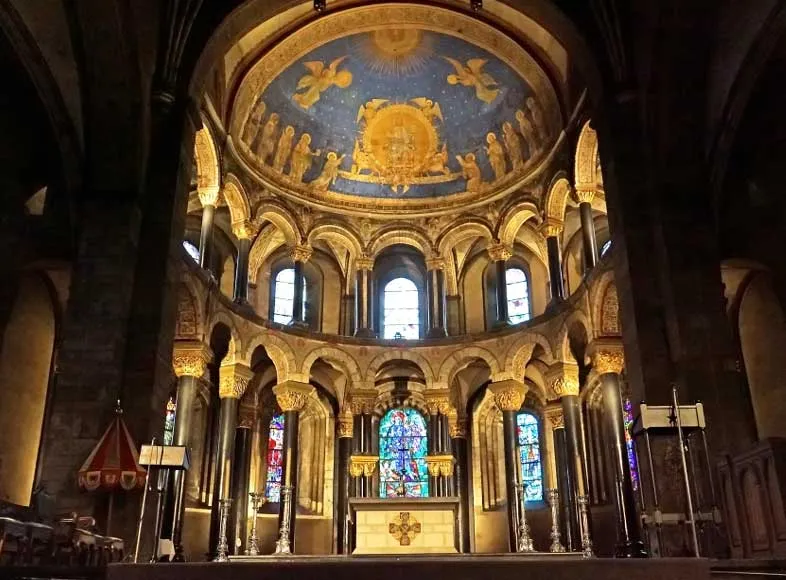
Architectural Style : Romanesque Architecture
A 13th-century Gothic portal, rebuilt in the 15th century, provides access to the church from Onze Lieve Vrouweplein. It is also the entrance of the so-called Mérode chapel (or Star of the Sea chapel). Although the interior of the church underwent many changes throughout the centuries, it has an ‘authentic’ Romanesque feel to it. This is largely due to the restoration ideas of the architect Pierre Cuypers, who had several of the larger Gothic windows replaced by small Romanesque windows, thus creating a darker, ‘mystical’ atmosphere.
Cuypers also removed the white plastering of the late Baroque period and had several altars built in a Romanesque or Gothic Revival style. Despite all these changes, the turbulent history of the building is still legible. Some murals dating from the Middle Ages have survived (including one of Saint Catherine from the 14th century). A mural on a pillar of Saint Christopher and the Infant Jesus dates from 1571. The large ceiling painting in the choir is Neo-Romanesque and dates from the Cuypers restoration. All stained glass windows are from the 19th or 20th century.
The furnishing of the church interior has followed the fashion of the time but suffered badly during the years of desecration (1798-1837). In 1380 the church had 33 altars but most of the medieval church inventory got lost in the turbulence that followed the arrival of the French in 1794. A precious baptismal font by the Maastricht metalworker Aert van Tricht survived but was stripped of most of its ornaments. Several Baroque confessionals and a richly carved pulpit were taken over from a former nearby Jesuit church. The 18th-century Baroque altar, now in the southern transept, is from the former Church of Saint Nicholas. The large pipe organ was built in 1652 by André Severin.
The architectural sculpture in the interior of the Basilica of Our Lady belongs to the highlights of Mosan art. The 20 highly symbolic capitals in the choir ambulatory depict scenes from the Old Testament, as well as various kinds of animals, monsters, birds, naked or scarcely dressed humans entangled in foliage, and humans fighting with animals. One capital in particular is famous as it was signed ‘Heimo’, probably by its maker who may also be represented on it, handing over a capital to the virgin Mary.
The carved capitals and corbels of the choir gallery, as well as the capitals in the nave, are of a slightly later date and less vivid, depicting mainly foliage with some human and animal figures. Most of the carved capitals, as well as some important reliefs elsewhere in the church, date from the second half of the 12th century. A close relationship has been established between the Romanesque sculpture in Our Lady’s and that in the Basilica of Saint Servatius in Maastricht, the Church of St Peter in Utrecht and the Schwarz rheindorf double chapel in Bonn.
Our Lady of Maastricht (Star of the Sea)
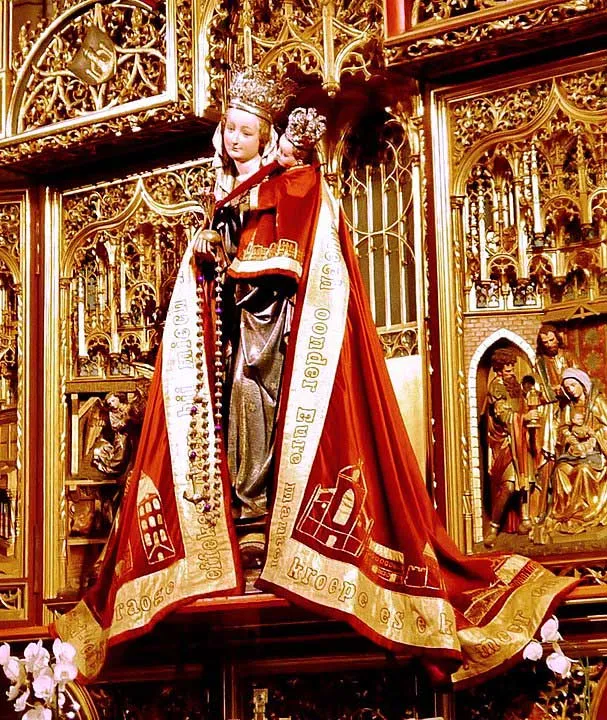
Sterre der Zee is the popular name of a 15th-century grace statue of Mary in Maastricht. The Roman Catholic Sterre der Zee devotion is particularly popular in the Southern Netherlands and Belgium. The papal crowned statue of Maastricht is set up in a side chapel of the Onze-Lieve-Vrouwe basilica, a church that is for this reason referred to as the ‘Sterre der Zee’. The veneration of Mary in Maastricht is much older than the veneration of the Star of the Sea. Both the Sint-Servaaskerk and the Onze-Lieve-Vrouwekerk used to have altars dedicated to Mary.
In the latter church is the 12th-century Heimo capital, on which the sculptor offers a beautifully worked capital to Mary, an early sign of Marian devotion in Maastricht. The oldest surviving statue of Mary in Maastricht is a Sedes Sapientiae from Maasland from around 1275 in the Sint-Servaaskerk. In 1281 a chapel on the Meuse is mentioned, which Maria Minor (Mary the Less) was mentioned. The designation ‘lesser’ in this case could indicate a subordination of the chapel to the chapter of the Church of Our Lady (Maria Maior). Later the name was changed to Maria ad littam (Maria ten Oevere).
The image of the Star of the Sea is a typical 15th-century Madonna and Child. It is not known exactly where and when it originated. Around 1470 it was donated by the nobleman Nicolaus van Harlaer to the Maastricht Friars Minor when he entered the monastery. From that time on it stood in a chapel on the south side of the choir of the Oude Minderbroederskerk. The popular devotion to the statue of Mary probably arose in the first quarter of the 16th century. In 1532, the annual Easter Monday procession from the Minderbroederskerk was mentioned in the Maastricht cedule book, in which “that bielt van onsser prefer Women” was carried along.
After the capture of Maastricht by Alexander Farnese in 1579, the re-Catholization began and a golden age began for the Franciscans and their Marian devotion. The monastery became a true place of pilgrimage, especially after some miraculous healings and four letters of indulgence granted (in 1607, 1614, 1628 and 1646). In 1609, the Maastricht Franciscan Henricus Sedulius describes in his book Diva Virgo Mosæ-Traiectensis (“The Divine Virgin of Maastricht”) the Marian devotion in his monastery, in which he recalls some miraculous healings. The procession on Easter Monday attracted thousands of participants: in 1608 about 6,000 men (excluding women and children); in 1611 some 20,000.

Henricus Sedulius gave a vivid description of the events of the Easter week of 1608. The sometimes ecstatic scenes are strongly reminiscent of the contemporary Semana Santa processions in Spain and South America, where many of these traditions have been preserved. On Easter Saturday the image of the Star of the Sea was first removed from the altar, after which it was placed on Easter Sunday before the still present choir screen was placed in the church. Here the people flocked, often shabbily dressed, sometimes barefoot, to worship the statue. Some crawled around it on their knees or threw themselves flat on the ground in penance. This went on all night. The prayer path was also walked, individually or in groups, some with burning torches. Some also got on their knees.
The highlight was the penitential procession on Easter Monday, after high mass, where all the notables of the city were present. A priest with the processional cross led the way, surrounded by a crowd, some also with a cross. Then followed the brotherhood of the scourges, led by the Jesuits (later the Dominicans), many in sackcloth, barefoot and with covered faces. In 1608 more than a thousand penitents went with them. After the second processional cross, all the religious of the city, Capuchins, Bogaarden, Crosiers, Augustinians, Dominicans and Friars Minor.
Then followed the Star of the Sea, carried on a procession bar by four friars and surrounded by the brotherhood of the flame-bearers. Near the statue walked dozens of penitents in iron armor with only a loincloth underneath, sometimes with heavy chains at their ankles. Their linen loincloths were soaked with the blood from the chafing of the armor. All the following week, penitents continued to walk the prayer path individually or in groups. On Beloken Easter, the following Sunday, the procession was repeated thinly.
The heyday of the Star-of-the-Sea devotion came to an end with the banishment of the Friars Minor after the so-called Treason of Maastricht (1638), in which the Friars Minor, among others, would have spied for the Spaniards. The statue went through a confusing period of wandering and eventually found shelter in the Minderbroederklooster in Tongeren, from where it did not return until 1675. No prayer paths or Star-of-the-Sea processions are known from that period of exile.
History of Our Lady of Maastricht
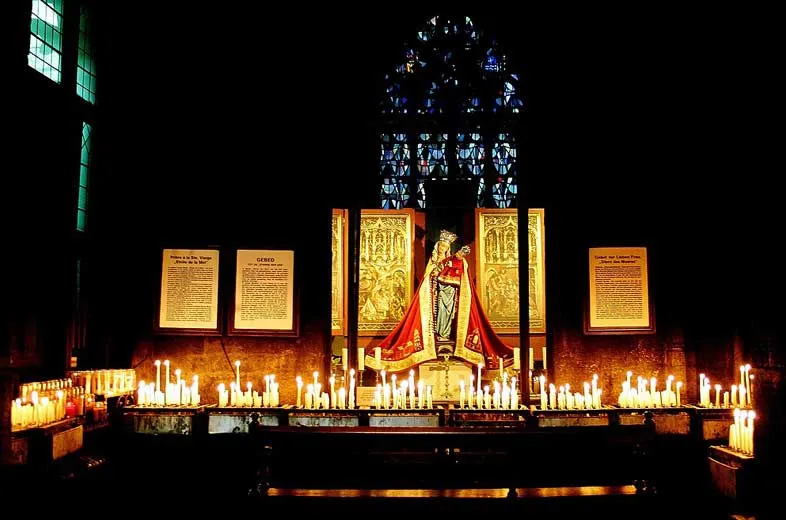
After the conquest of Maastricht in 1673 by the Catholic French King Louis XIV, the Friars Minor returned to the city, initially in a few houses near St. James’s Chapel. Later, they regained access to a wing and a makeshift chapel in their old monastery. The Sterre der Zee returned from Tongeren in 1674. The statue was taken several times in procession from St. James’s Chapel, in 1676 in a prayer procession prescribed by the city council, in 1677 in a penitential procession and a year later in an Easter Monday procession. From 1678 the political tide turned and public processions were banned by the Protestant Republic of the United Provinces, which co-ruled the city.
From 1699 to 1707, the Friars Minor built a new church and monastery on the Minderbroedersberg, the Tweede Minderbroedersklooster. Here the Star of the Sea was given a place of honor on the main altar in the church (1699). A lay brotherhood had been associated with the statue since 1701 (until 1782 only for unmarried men). Processions remained banned; the statue was only allowed to be carried around on private property.
One could, however, walk the prayer path on one’s own, a ‘quiet meeting’, in a certain sense a painful reminder of the grand processions of the past. The route was adjusted, since the starting point was no longer the Oude, but the Tweede Minderbroederskerk. Later, the legend of finding the forgotten route was invented here, pointed out by a star of the sea that had come to life.
The capture of Maastricht by the French revolutionaries in 1794 and the annexation to France in May 1795 meant the end of all monasteries in Maastricht a few years later. The Friars Minor also had to pack their bags and the famous statue of Mary was hidden by members of the Brotherhood of the Star of the Sea. In 1804 the statue was transferred to St Nicholas’ Church, where it was placed on an altar in the north aisle. The Confraternity of Our Lady of the Immaculate Conception, founded in 1714 in that church, focused from 1804 on the devotion of the Star of the Sea.
In 1837 the statue moved – with the parish – to the adjacent Church of Our Lady, where it was also erected in the north aisle. The route of the prayer road hardly needed to be adjusted after these relocations, since both churches were already on the prayer road. Only the part to the church on the Minderbroedersberg, which has since been converted into a court, has fallen into disrepair. The procession ban remained in force and was vigorously enforced until the beginning of the 20th century.
That the prayer path was also walked individually or in small groups at this time is apparent from a report from 1841 that some well-dressed ladies made this journey barefoot. Also noted the blanketvan Maastricht in 1857 that the prayer path was walked daily, especially around Easter time, by small groups of believers.
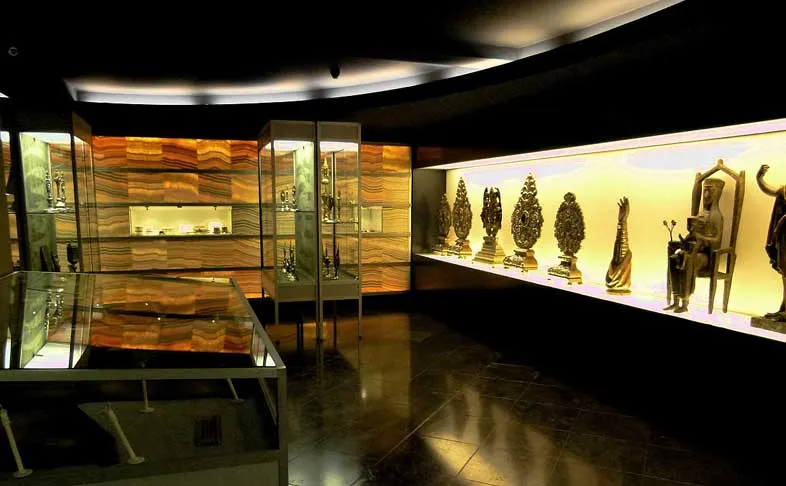
New Bloom Time
The worship of the Star of the Sea increased strongly in the course of the 19th century. Especially in times when Limburg was ravaged by cholera epidemics, the Sterre der Zee was visited by many thousands of pilgrims. When the Franciscans again had a monastery in Maastricht after 1865, they repeatedly asked for the statue to be returned, but the Roermond bishop Joannes Paredis was able to prevent this. After almost thirty years, the Sterre der Zee had become inseparably linked to the Church of Our Lady.
At the beginning of the 20th century, the devotion increased further, partly at the hands of the then pastor Piet Jacobs (1850-1930). The move of the statue to the De Mérode chapel gave a great boost to the devotion to the statue. The restoration of the Maria-bidweg in 1904 and the merger between the two Maria confraternities in 1906 were a logical continuation of this. In 1912, the Marian Congress and the festive coronation of the Star of the Sea were provisional highlights.
Looking back, Pastor Jacobs admitted in 1912 that publicly promoting the prayer path in 1904 had been a risk, but one he would have been happy to take. During the Marian Congress, the prayer path was walked daily by hundreds, sometimes thousands of people. During the World War I, a prayer procession for peace was held every Saturday. On May 7, 1918, 5,000 people took part in this prayer road. The Marian devotion, and in particular that of the Sterre der Zee, was strongly encouraged around the middle of the 20th century by the Bishop of Roermond, Mgr. Lemmens (1932-1958).
Lemmens used the motto Stella Duce (‘Guided by the star’) in his bishop’s coat of arms. Lemmens was also there when on April 17, 1933 – the day the Onze-Lieve-Vrouwekerk was elevated to a basilica minor – the disused Easter Monday procession set out again, not the original route, but a short “circle around the church”. In October 1939, Maastricht schoolgirls took the prayer path to pray for world peace. A week later, the boys walked the same route.
After World War II every year on September 14, the day of the liberation of Maastricht, a large prayer road was organized, again with Bishop Lemmens. In those years, the prayer path was also walked by many individually. From 1950 to 1955, the Sterre der Zee made a tour of the parishes of Limburg, a journey of 2,000 kilometres. The tour was accompanied by Bishop Lemmens and by two brother masters of the Brotherhood of the Star of the Sea. The statue was received en masse and enthusiastically almost everywhere. Until about 1960, group pilgrimages to Maastricht were also organized from all parts of the Netherlands.
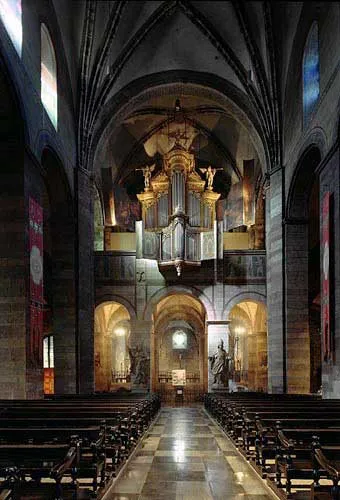
Cloisters and Star of the Sea Chapel
Access to the cloisters, which enclose a garden, is through the church. The current cloisters were built in marlstone in late Gothic style with some Renaissance elements in 1558/59. They replaced the older Romanesque cloisters, of which some capitals have survived in the collection of the Bonnefanten Museum. The floor of the cloisters is paved with monumental grave stones, some of them from the demolished Saint Nicholas Church. In 1910 a tower of the Roman castrum was found in the cloister garden.
For many people the main attraction of the Basilica of Our Lady is the miraculous statue of Our Lady, Star of the Sea. This 15th-century wooden statue was originally housed in a nearby Franciscan monastery. In 1801 it was moved to the former parish church of Saint Nicholas, adjacent to Our Lady’s. After the closure of that church in 1837, the statue moved to Our Lady’s. In 1903 it was placed in a Gothic chapel near the main entrance where it remains today and where it is daily visited by hundreds of worshipers. Pope Pius X crowned the venerated Marian image on 15 August 1912 via the Bishop of Roermond, Joseph Hubert Drehmanns. Twice a year it is being carried around town in the city’s religious processions.
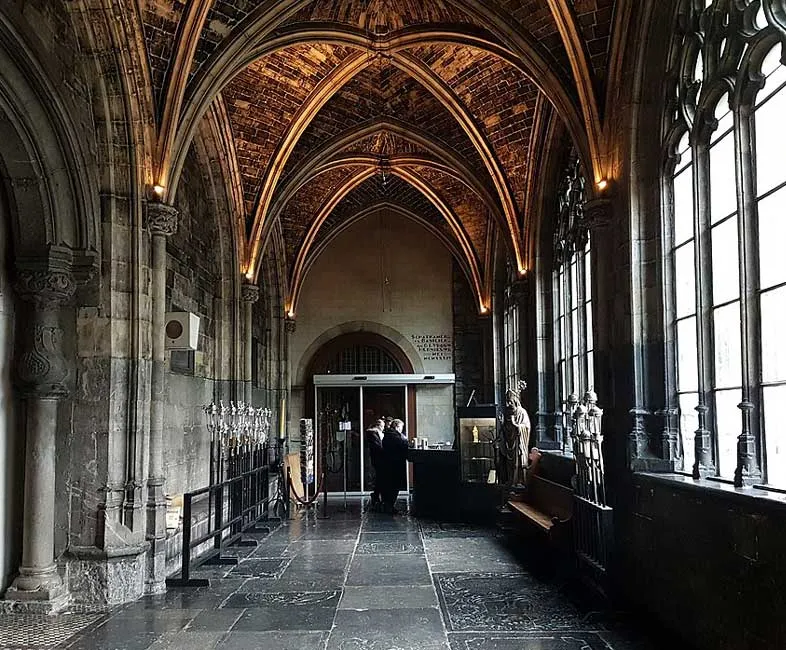
Treasury
The Basilica of our Lady possesses an important historical church treasure consisting of relics, reliquaries, textiles and liturgical objects. From the 14th century onwards it had a separate treasury room, which at one point was located in the Tower of Saint Barbara. It is believed that the choir gallery of Our Lady’s was specifically built in the 12th century for the public showing of the recently acquired relics from Constantinople.
During the Middle Ages great rivalry existed between Maastricht’s two religious chapters. At several occasions the chapter of Saint Servatius complained about the fact that the canons at Our Lady’s showed their relics in the open air, which only Saint Servatius was allowed to do. The relics display, especially at the time of the Septennial Pilgrimage, drew large numbers of pilgrims from all over Europe, bringing in revenue for the churches.
Today the church treasure is only a fraction of what it once was. Many gold and silver objects were melted down in order to pay for war taxes during the tumultuous period after the French conquest of Maastricht in 1794. Other pieces were sold for personal gain or given away. Even as late as 1837, the church lost two of its most precious possessions out of ignorance. A 10th-century reliquary in the shape of a patriarchal cross, allegedly containing the largest particle of the True Cross, and the so-called “pectoral cross of Constantine” (both originating from Constantinople and probably taken to Maastricht by crusaders) were given away by a former canon and are now in the treasury of the St. Peter’s Basilica in Vatican City.
Two copper-gilt reliefs depicting angels are now in the Treasury of the Basilica of Saint Servatius. In some cases the reliquaries were lost but the content (the relics) was saved. This is the case with the so-called “Virgin’s Girdle”. Of the original silver statues of the Virgin and two angels only a silver tube with the girdle survived.
The treasure of the basilica of Our Lady as it is today consists of reliquary boxes, cases or busts made of (gilded) silver or copper, silvered lead, brass, ivory, horn, bone and wood; chalices, patens, monstrance’s and other liturgical implements made of silver, silver-gilt, brass or tin; ecclesiastical vestments and ancient fabrics used for wrapping relics; antique books and manuscripts; paintings, prints and sculptures; and some archaeological finds.
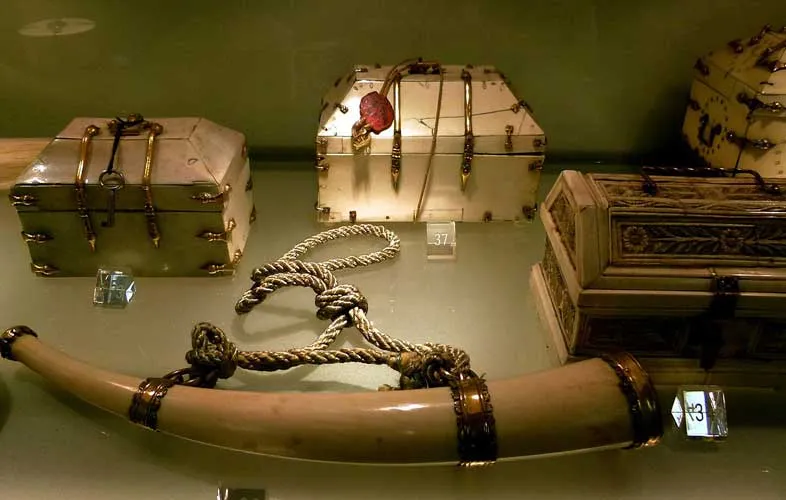
Feast Day - 19th March
Annual Feast Day of Our Lady of Maastricht held on 19th March.
Feast of Saint Servatius (patron saint of Maastricht) The City Procession is held on the Sunday after May 13, in which all churches and Catholic groups and associations participate. The City Procession moves from the Basilica of Saint Servatius to the Basilica of Our Lady of Maastricht.
Mass Time
Weekdays
Saturdays
Sundays
Church Visiting Time
Contact Info
Basilica of Our Lady of Maastricht,
7, Onze Lieve Vrouweplein,
6211 HD, Maastricht, Netherlands
Phone No.
Tel : +31 43 321 3854
Accommodations
How to reach the Basilica
Maastricht Aachen Airport in Maastricht in Limburg, Netherlands is the nearby Airport to the Basilica.
Maastricht Railway Station in Maastricht in Limburg, Netherlands is the nearby Railway Station to the Basilica.








